Generate Statements Task
The Generate Statement task in the Task Scheduler replaces the manual process of running the Statements from the Reports menu. The user sets the options, exclusions, messages, and the process date. The Statement Options match those available when generating statements manually.
Upon the completion of the task, the statements will be generated according to the settings and automatically transmitted to EDI or downloaded based on the account settings. The Statement Report will be provided to the user via the tickler upon completion. However, there is no opportunity to review the Statement Report prior to transmission.
- Click the Add New Task button.
-
Select Generate Statements from the Add New
Task window.

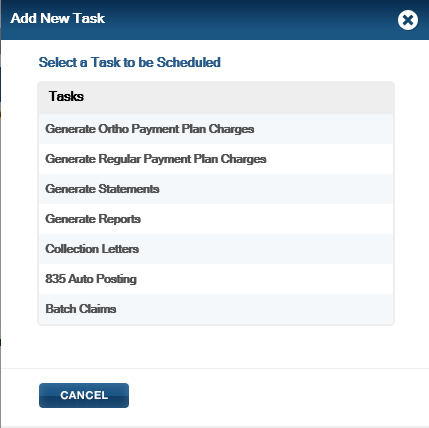
-
Complete the fields on the Details tab of the
Generate Statements window.
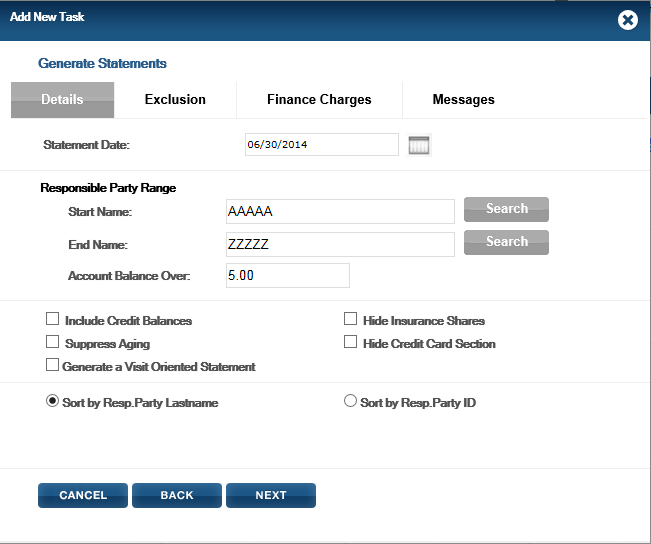
Statement Date: Set the date to be printed on the Statement AND set as the last Statement date.
Note: Typically this date is set as the last day of the month, and is at least one day prior to the generation of the statements.Responsible Party Range: Statements can be sent to a focused group of responsible parties, defined by last name, and managed alphabetically. By default, statements would be sent to all responsible parties whose last name falls within the range of AAAAA to ZZZZZ –in other words, all responsible parties. That range may be manually adjusted, if required.
Account Balance Over: Statements can be limited to accounts that have more than a specific balance.Set this limit by typing the minimum balance.For example, if the Account Balance Over is set to $5, accounts with a balance over $5 will receive statements, while those whose balance is under $5 would not.
Include Credit Balances: Select this checkbox to send statements to accounts with a credit balance.
Suppress Aging: Select this checkbox to hide the section displaying the balance with aging levels.
Hide Insurance Shares: Select this checkbox to hide the section displaying the estimated insurance portion of the balance.Please be aware that the insurance portion appears to be assigned to the patient.
Hide Credit Card Section: Select this checkbox to hide the pay by credit card section.
Sort By: Set the order in which the accounts will be listed in the Statement Report and the order in which the statements will ultimately be generated.
-
Click the Next button.

-
Select the accounts that should not receive statements from the
Exclusions tab of the Generate Statements
window.
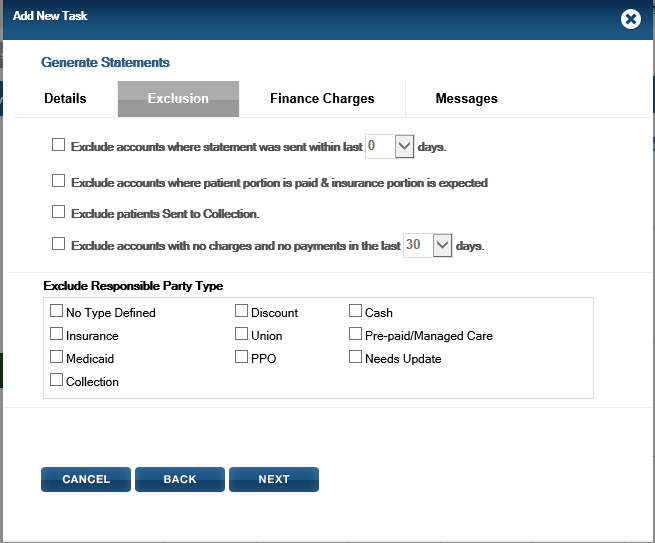
Exclude accounts where statement was sent within last X days: Select this check box if accounts should not receive a statement because it was sent within a specific time period. The specifics of how recent a visit can be selected via the dropdown.
Exclude accounts where patient portion is paid & insurance portion is expected: Select this check box to prevent accounts from receiving statements if there is only an insurance balance.
Exclude patients Sent to Collection: Select this check box to prevent accounts that are already in the collection process from receiving a statement. Accounts are considered “Sent to Collection” when the Sent to Collection check box is selected in the Responsible Party screen.
Note: This is not the same as using a Collections Responsible Party Type.Exclude accounts with no charges and no payments in the last X days: Select this check box to prevent accounts that have had no activity (charges and payments) within a specific time period. The specifics of that time period can be selected via the dropdown.
Exclude Responsible Party Type: Responsible Party types describe or categorize responsible parties in a way that is useful to the practice. Specific responsible party types may be excluded from receiving statements. Place a check mark beside the responsible party types that should not receive statements.
-
Click the Next button.

-
Set the finance charges, if desired.

Finance Charge Date: Set the date on which the finance charges will be calculated and applied.
Exclude Responsible Party Type: Responsible Party types describe or categorize responsible parties in a way that is useful to the practice. Specific responsible party types may be not be charged the finance charges. Place a check mark beside the responsible party types that should not have a finance charge applied.
Provider: Set the provider that should be associated with the finance charge.
Use existing finance charges: Click this radio button to calculate and apply the finance charge percentage and amounts as established in the office Setup.
Define new finance charges: Click this radio button to set specific finance charges that are different from those established in the office setup.Please note that the annual charge, minimum balance, minimum finance charge, and aged date must be established.
-
Click the Next button.

-
Set the messages that should appear on the Statement.
Note: If no message is set, the practice and office defaults will apply.
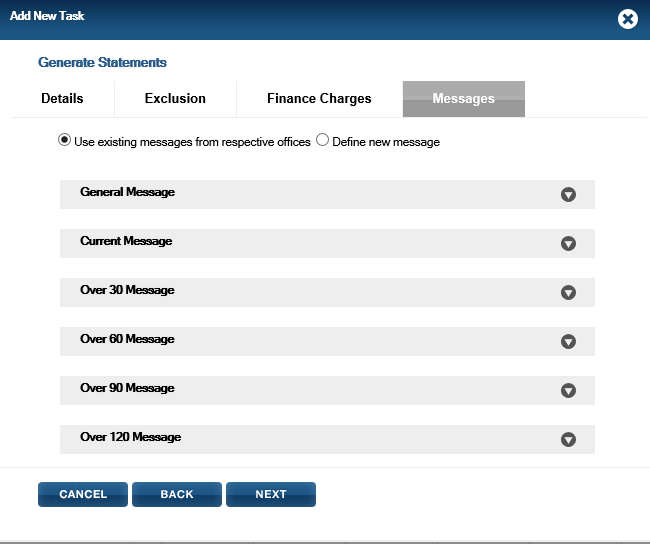 Note: Specific messages may be included at the bottom of the statement.
Note: Specific messages may be included at the bottom of the statement. - Select the radio option beside Use existing messages from respective offices to use the messages established in the office setup.
- Select the radio button beside Define new message to override the pre-set messages and define a custom message. Type the message as desired for each of the aged options.
-
Click the Next button.

-
Select the office(s) whose patients should receive statements.
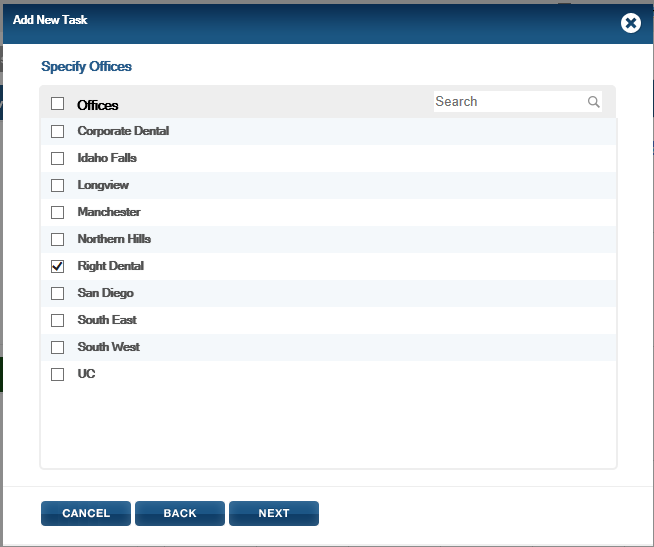
- Click the Next button.
-
Type a name for the task.
Note: This name appears in the task panels and within the scheduler view.

-
Select a color for the task from the dropdown.
Note: This color will be displayed for the task within the scheduler view. Many practices will set guidelines for color-coding tasks.

-
Set the interval for the task to be performed.
Note: The selection made here will trigger the frequency options at the bottom of the window.

Only One Time: The task will be performed once on the date and time indicated.
Daily: The task will be performed each day as setup in the frequency settings.
Weekly: The task will be performed each day as indicated in the frequency settings.
Monthly: The task will be performed once each month as indicated in the frequency settings.
-
Set the date that QSIDental Web should begin performing the task by typing the date or
selecting it from the calendar. The begin date does not need to correspond to the
frequency cycle.

-
Set the date that QSIDental Web should discontinue performing the task by typing the
date or selecting it from the calendar.
Note: This option only appears when a frequency interval is selected.

-
Set the time that the task should begin by typing the time directly or selecting from
the clock dropdown.

-
Set the frequency options for Daily, Weekly, or Monthly performance of the task
(triggered based on the selection made for interval and dependent on that selected
interval).
Daily: The task may be performed every day or on alternate days as specified

To perform the task every single day, select the radio button beside Every Day
To perform the task on a regular daily interval, select the radio button beside Everyx days and choose the specific interval from the dropdown.
For example: To run the collection letters every other day, click the radio button beside Every X days and select 2 from the dropdown.
Weekly: The task may be performed one or more times per week on certain days as specified.
Select the number of weeks between the performance of the tasks.Selecting “1” will set the task to be performed each week.Selecting “3” will set the task to be performed every third week.
Select the day(s) of the week the task should be performed during the scheduled weeks by placing a check mark beside the desired day(s) of the week.
For example: To run the collection letters on alternate Wednesdays, select 2 in the Recur Every field and select Wednesday from the Weeks on field.
Monthly: The task may performed on a specific date or day as specified.

To perform the task on a specific day of the month, select the radio button beside Day and select the specific date.To manage different month lengths, “Last day of the month” may be selected.
To perform the task on a specific day of the week, select the radio button beside The X weekday and set the specific cycle within the month such as 2nd Friday.
Select the month(s) the task should be performed during the year by placing a check mark beside the desired month(s).
For example: To run the collection letters on the 15th of the month ending the quarter, select the radio button beside Day and select 15. Place check marks in the months of March, June, September, and December.
- If desired, place a check mark beside Send Task Completion Notification via Email to activate the confirmation email options. This notification is in addition to the task completion notice and report delivered via the QSIDental Web Tickler tool. The notification is only of the successful or unsuccessful completion of the task and does not contain any data.
- Click the Next button.
-
If Completion Notification was selected, identify the
individual(s) that should receive notification that the task as been completed by typing
the email address(es). Once the email address is entered, it will be saved for easy future
use. Click the Next button again.
Note: This screen will not appear if the notification is not requested on the previous screen.
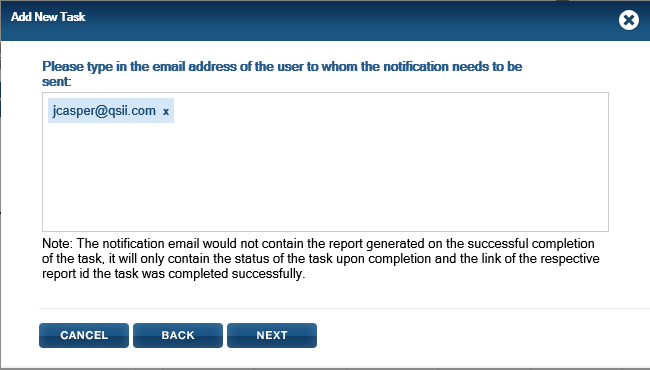
- Review the details and click the Finish button.
